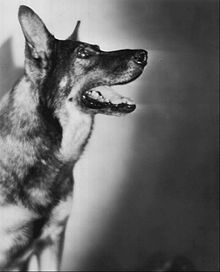
Back Rin Tin Tin Czech Rin Tin Tin German Rin Tin Tin Spanish Rin Tin Tin Basque رین تین تین Persian Rin Tin Tin Finnish Rintintin (acteur canin) French רין טין טין HE Ռին Տին Տին Armenian Rin Tin Tin Italian

Rin Tin Tin or Rin-Tin-Tin (September 10, 1918 – August 10, 1932) was a male German Shepherd born in Flirey, France, who became an international star in motion pictures. He was rescued from a World War I battlefield by an American soldier, Lee Duncan, who nicknamed him "Rinty". Duncan trained Rin Tin Tin and obtained silent film work for the dog. Rin Tin Tin was an immediate box-office success and went on to appear in 27 Hollywood films, gaining worldwide fame. Along with the earlier canine film star Strongheart, Rin Tin Tin was responsible for greatly increasing the popularity of German Shepherd dogs as family pets. The immense profitability of his films contributed to the success of Warner Bros. studios and helped advance the career of Darryl F. Zanuck from screenwriter to producer and studio executive.
After the dog's only appearance in color (the 1929 musical revue The Show of Shows, in which he barks an introduction to a musical pageant), Warner Bros. dispensed with Rin Tin Tin's and Lee Duncan's services. The studio was intent on promoting its "all-talking" stars, and silent-film personality Rin Tin Tin obviously couldn't speak. Undaunted, Duncan sought further film work and signed with independent producer Nat Levine, who starred Rin Tin Tin in serials and feature films.
After Rin Tin Tin died in 1932, the name was given to several related German Shepherd dogs featured in fictional stories on film, radio, and television. Rin Tin Tin Jr. appeared in some serialized films, but was not as talented as his father.[1] Rin Tin Tin III, said to be Rin Tin Tin's grandson, but probably only distantly related, helped promote the military use of dogs during World War II. Rin Tin Tin III also appeared in a film with child actor Robert Blake in 1947.
Duncan groomed Rin Tin Tin IV for the 1950s television series The Adventures of Rin Tin Tin, produced by Bert Leonard. However, the dog performed poorly in a screen test and was replaced in the TV show by trainer Frank Barnes's dogs, primarily one named Flame Jr., called JR, with the public led to believe otherwise. Instead of shooting episodes, Rin Tin Tin IV stayed at home in Riverside, California. The TV show Rin Tin Tin was nominated for a PATSY Award in both 1958 and 1959 but did not win.
After Duncan died in 1960, the screen property of Rin Tin Tin passed to his business partner Bert Leonard, who worked on further adaptations such as the 1988–1993 Canadian-made TV show Katts and Dog, which was called Rin Tin Tin: K-9 Cop in the US and Rintintin Junior in France. Following Leonard's death in 2006, his lawyer James Tierney made the 2007 children's film Finding Rin Tin Tin, an American–Bulgarian production based on Duncan's discovery of the dog in France. Meanwhile, a Rin Tin Tin memorabilia collection was being amassed by Texas resident Jannettia Propps Brodsgaard, who had purchased several direct descendant dogs from Duncan beginning with Rinty Tin Tin Brodsgaard in 1957. Brodsgaard bred the dogs to keep the bloodline. Brodsgaard's granddaughter, Daphne Hereford, continued to build on the tradition and bloodline of Rin Tin Tin from 1988 to 2011; she was the first to trademark the name Rin Tin Tin, in 1993, and she bought the domain names rintintin.com and rintintin.net to establish a website. Hereford opened a short-lived Rin Tin Tin museum in Latexo, Texas and passed the tradition to her daughter, Dorothy Yanchak, in 2011. The dog Rin Tin Tin XII, owned by Yanchak, takes part in public events to represent the Rin Tin Tin legacy.
- ^ Orlean 2011, p. 94.